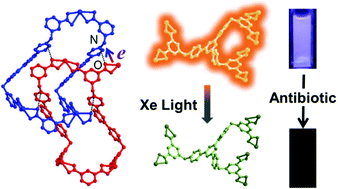Photoresponsivity and antibiotic sensing properties of an entangled tris(pyridinium)-based metal–organic framework†
Abstract
A two-dimensional Cd(II) metal–organic framework (MOF) was constructed from a tris(pyridinium)-based hexacarboxylate zwitterionic ligand. The MOF shows a novel fashion of 2-fold 2D → 2D parallel entanglement. It is the entanglement that dictates close interlayer contacts between carboxylate (electron donor) and pyridinium (acceptor), which in turn impart the MOF with reversible photochromic properties through photoinduced electron transfer (PET). This is an extension of PET-based photochromism from bipyridinium to multipyridinium compounds. Thanks to the photoresponsive behaviour, the fluorescence of the MOF can be reversibly modulated or switched by photoirradiation. Besides, the fluorescence of the water-stable MOF in aqueous dispersion is very sensitive to nitrofuran antibiotics with high selectivity, and therefore the MOF is a good candidate of efficient and regenerable sensing material for determination of the antibiotics in water media.



 Please wait while we load your content...
Please wait while we load your content...